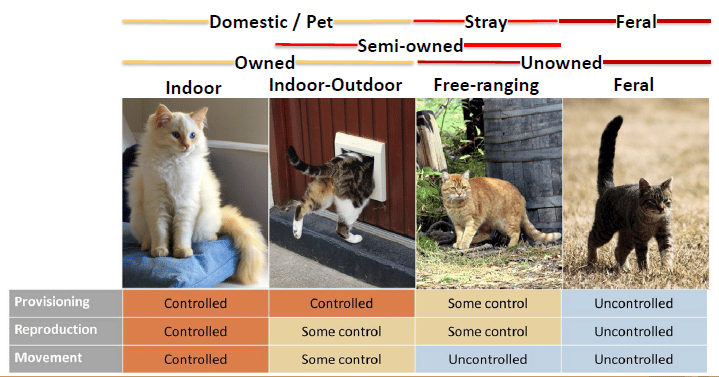Information
TERMINOLOGY MATTERS:
Pet, owned, domestic, non-domestic, stray, semi-owned, free-roaming, semi-feral, unowned, feral
Cats are all the same species Felis catus, but can be grouped into categories based on where and how they live.
In Western Australia, cats are generally assigned from a management perspective to one of three categories: domestic, stray and feral, although all prey on native fauna. Feral cats are listed as a declared pest under the WA Biosecurity and Agriculture Management Act 2007. The policy statement that supports it provides further definitions.
Elsewhere in Australia and oversea, cat category terminology is applied in different and often inconsistent ways. For example, in the USA and Europe free-roaming and feral cats, respectively refer to what Western Australia terms ‘stray cats’. This terminology mis-match creates problems – when Australian content uses the term ‘feral cat’, it frequently attracts criticism from international cat welfare agencies, which can result in misdirected propaganda.
For clarity and in alignment with Western Australian legislation, we use three categories on this website – pet, stray or feral – where differentiation is appropriate. When no category is mentioned, it should be assumed the statement is inclusive of all three categories.
Pet Cats
(domestic, owned) live with and are generally dependent on humans for food and habitation; they are socially important and are legally permitted in Australia. There is legislation in most states regarding ownership and variable requirements to register, sterilise and identify (i.e. microchips, collars) the animal.
Stray Cats
(semi-feral) are often found in and around urban areas, rural properties, industrial areas or rubbish tips. They are either in self-sustaining populations or become stray following neglect or irresponsible pet ownership; some depend on resources provided by humans.
Feral Cats
live and reproduce in the wild in self-sustaining populations in natural habitats of all types They are not reliant on humans and survive exclusively by hunting and scavenging.

Responsible pet cat ownership
Owners of pet must comply with the WA Cat Act 2011 (Cat Act) and any requirements such as cat-prohibited areas designated by local government.
The Cat Act requires all cats to be sterilised, microchipped and registered by six months of age.
Cat owners should refer to the RSPCA Australia information booklet ‘Keeping your cat safe and happy at home’ and keep domestic cats inside, particularly at night, or have an outdoor cat enclosure, especially if living in rural or remote areas.
Pet cat owners should ensure their cats are microchipped and their registration tag is worn on their collar, per requirements of the Cat Act. This will allow them to be clearly identified as domestic cats. Microchipping also means that cats can be returned quickly and easily should they get out.
More information on responsible pet ownership.
Image credits on this page
[Judy Dunlop]
